Norwegian Pitched Roof Defects
Abstract
:1. Introduction
1.1. Wood Building Traditions and Climate Exposure
1.2. Building Defects and Robustness
1.3. Objective and Scope
2. Pitched Wooden Roof Constructions
2.1. Design Principles
- (1)
- moisture from the roof, and thus prevent mould growth and other moisture damage; and
- (2)
- heat, and thus prevent unwanted melting of snow and ice at the eaves and gutters.
- Pitched wooden roofs with separate wind barrier and underlayer roof (ventilation air cavity between wind barrier and underlayer roof).
- Pitched wooden roofs with combined underlayer roof and wind barrier (watertight vapour open membrane).
- Pitched wooden roofs with cold attics.
- Pitched wooden roofs with heated rooms in parts of the attic.
2.2. Type A—Pitched Wooden Roof with Separate Wind Barrier and Underroof
- raintight roofing;
- drainage and ventilation cavity;
- vapour-tight underlayer roof;
- ventilation cavity; and
- vapour open wind barrier.
2.3. Type B—Pitched Wooden Roofs with Combined Wind Barrier and Underlayer Roof
- raintight roofing;
- drainage and ventilation cavity; and
- combined vapour open and watertight wind barrier and underlayer roof.
2.4. Type C—Pitched Wooden Roofs with Cold Attics
- (a)
- Cold, ventilated attic space with air stream flowing through the attic itself. The underlayer roof may be vapour tight. There are ventilation openings in the ridge and between the underlayer roof and the thermal insulation along the eaves of the building. Ventilation openings have to be designed in order to avoid penetration of snow and rain into the attic. Only the vapour retarder contributes to the airtightness of the building (ceiling), making the solution vulnerable to holes and imperfections in the vapour retarder, which again can cause condensation because of air (containing moisture) leakages through the construction. Hagentoft et al. [15] found that the moisture level of cold ventilated lofts is improved if the attic floor is airtight, has low built-in moisture content, and has well-ventilated indoor air.
- (b)
- Cold, unventilated attic space with all ventilation between the underlayer roof and roof covering. The construction is a further development of a) and an improved roof design. The underlayer roof is a vapour open and watertight wind barrier. Both the wind barrier and vapour retarder should be used continuously, thus making it easier to ensure airtightness of the building.
2.5. Type D—Pitched Wooden Roofs with Heated Rooms in Part of the Attic
- (a)
- Thermally non-insulated ventilated attic. The underlayer roofing can be vapour tight. There are ventilation openings in the ridge and between the underlayer roof and the thermal insulation along the purlin of the building. Ventilation openings have to be designed in order to avoid penetration of snow and rain into the attic. The vapour retarder and wind barrier are not continuous through the floor construction and the roof is therefore particularly vulnerable to moisture damage due to air leakages.
- (b)
- Thermally insulated non-ventilated attic. The underlayer roof has to be vapour open. The construction is a further development of a) and an improved solution. It is possible to make a continuous and airtight joint between the wind barrier on the wall and the underlayer roof, thus making the construction more resistant to moisture compared to a).
3. Analysis of Norwegian Roof Defects
3.1. SINTEF Building Defect Archive
3.2. Building Defects Versus Source of Defect
3.3. Typical Damage and Defects
4. Discussion
4.1 Type A—Pitched Wooden Roofs with Separate Wind Barrier and Roofing Underlay
4.2 Type B—Pitched Wooden Roofs with Combined Wind Barrier and Roofing Underlay
4.3 Type C—Pitched Wooden Roofs with Cold Attics
4.4 Type D—Pitched Wooden Roofs with Heated Rooms in Part of the Attic
5. Conclusions
Acknowledgments
Author Contributions
Conflicts of Interest
References
- O’Brien, K.; Sygna, L.; Haugen, J. Vulnerable or resilient? A multi-scale assessment of climate impacts and vulnerability in Norway. Clim. Change 2004, 64, 193–225. [Google Scholar] [CrossRef]
- Lisø, K.; Time, B.; Kvande, T. Building enclosure performance in a more severe climate. In Research in Building Physics—Proceedings of the Second International Conference on Building Physics; A.A. Balkema Publishers: Leuven, Belgium, 2003; pp. 309–317. [Google Scholar]
- Bauer, I.H.; Førland, E.J.; Haddeland, I.; Mayer, S.; Nesje, A.; Nilsen, J.E.Ø.; Sandven, S.; Sandø, A.B.; Sorteberg, A.; Ådlandsvik, B. Klima i Norge 2100 (Climate in Norway 2100); Norwegian environment Agency: Oslo, Norway, 2015. (In Norwegian) [Google Scholar]
- Jelle, B.P. Accelerated climate ageing of building materials, components and structures in the laboratory. J. Mater. Sci. 2012, 47, 6475–6496. [Google Scholar] [CrossRef]
- Jelle, B.P.; Breivik, C.; Røkenes, H.D. Building integrated photovoltaic products: A state-of-the-art review and future research opportunities. Solar Energy Mater. Sol. Cells 2012, 100, 69–96. [Google Scholar] [CrossRef]
- Breivik, C.; Jelle, B.P.; Time, B.; Holmberget, Ø.; Nygård, J.; Bergheim, E. Large-scale experimental wind-driven rain exposure investigations of building integrated photovoltaics. Sol. Energy 2013, 90, 179–187. [Google Scholar] [CrossRef]
- Gullbrekken, L.; Kvande, T.; Time, B. Roof-integrated PV in nordic climate—Building physical challenges. Energy Proced. 2015, 78, 1962–1967. [Google Scholar] [CrossRef]
- Jelle, B.P.; Sveipe, E.; Wegger, E.; Gustavsen, A.; Grynning, S.; Thue, J.V.; Time, B.; Lisø, K.R. Robustness classification of materials, assemblies and buildings. J. Build. Phys. 2014, 37, 213–245. [Google Scholar] [CrossRef]
- Ingvaldsen, T. Byggskadeomfanget i Norge en Vurdering Basert På et Tidligere Arbeid og Nye Data (Building Defects in Norway an Assessment Based on Earlier Work and New Data); Prosjektrapport 17; SINTEF Byggforsk: Oslo, Norway, 2008. (In Norwegian) [Google Scholar]
- Kvande, T.; Lisø, K.R. Climate adapted design of masonry structures. Build. Environ. 2009, 44, 2442–2450. [Google Scholar] [CrossRef]
- Lisø, K.R.; Kvande, T.; Thue, J.V. Research in Building Physics and Building Engineering; Tyler & Francis: Oxford, UK, 2006; pp. 425–432. [Google Scholar]
- Lisø, K.R.; Kvande, T.; Vincent, J.V. The Robustness of the Norwegian Building Stock—A Review of the Process Induced Building Defects. In Proceedings of the 7th Symposium on Building Physics in the Nordic Countries, Reykjavík, Iceland, 13–15 June 2005.
- Edvardsen, K.; Ramstad, T. Trehus Håndbok 5 (Wooden Houses Handbook No 5); SINTEF Building and Infrastructure: Oslo, Norway, 2014. (In Norwegian) [Google Scholar]
- Pedersen, T.E.; Bakken, N.; Time, B. Regntetthet for Kombinerte Undertak og Vindsperrer på Rull (Raintightness of Combined Underlayer Roofings and Wind Barriers); Prosjektrapport 23; SINTEF Building and Infrastructure: Trondheim, Norway, 2008. (In Norwegian) [Google Scholar]
- Hagentoft, C.-E.; Sasic Kalagasidis, A. Moisture safe cold attics—Assessment based on risk analyses of performance and cost. In Proceedings of the 10th Nordic Symposium on Building Physics, Lund, Sweden, 15–19 June 2014.
- Lisø, K.; Kvande, T. Klimatilpassing av Bygninger (Climate Adaption of Buildings); SINTEF Building and Infrastructure: Oslo, Norway, 2007. (In Norwegian) [Google Scholar]
- Calonne, N.; Flin, F.; Morin, S.; Lesaffre, B.; Du Roscoat, S.R.; Geindreau, C. Numerical and experimental investigations of the effective thermal conductivity of snow. Geophys. Res. Lett. 2011, 38, 1–6. [Google Scholar] [CrossRef]
- Juul, H.; Bøhlerengen, T. Ising på Tak En Studie av et Skadetilfelle (Ice Formation on Roofs—A Study of Damages); Norwegian Building Research Institute: Oslo, Norway, 1990. (In Norwegian) [Google Scholar]
- Lossius, P.; Bøhlerengen, T. Takstein Snø og Brekkasje (Concrete Roofing, Snow and Damage); Prosjektrapport 67; Norwegian Building Research Institute: Oslo, Norway, 1990. (In Norwegian) [Google Scholar]
- Geving, S. Fuktskader Årsaker, Utbedringer og Tiltak (Moisture Damage: Reasons, Improvements and Actions); SINTEF Building and Infrastructure: Oslo, Norway, 2011. [Google Scholar]
- Mahendran, M. Fatigue Behaviour of Corrugated Roofing under Cyclic Wind Loading; James Cook University of North Queensland: Queensland, Australia, 1990. [Google Scholar]
- Uvsløkk, S. Moisture and temperature conditions in cold lofts and risk of mould growth. In Proceedings of the Nordic Building Conference, Tampere, Finland, 29 May–2 June 2011.
- Dek, A. Research on the Lifetime of Membranes. DEKTIME Special 01; Atelier Dek: Prague, Czech, 2012. [Google Scholar]
- Brandt, E.; Hansen, E.J. Durability of roof underlays exposed to long time exposure under in-use conditions. In Proceedings of the XIII International Conference on Durability of Building Materials and Components, Sao Paulo, Brazil, 2–5 September 2014.
- Nordtest Method NT BUILD 495 Building Materials and Components in the Vertical Position: Exposure to Accelerated Climatic Strains; Nordtest: Espoo, Finland, 2000.
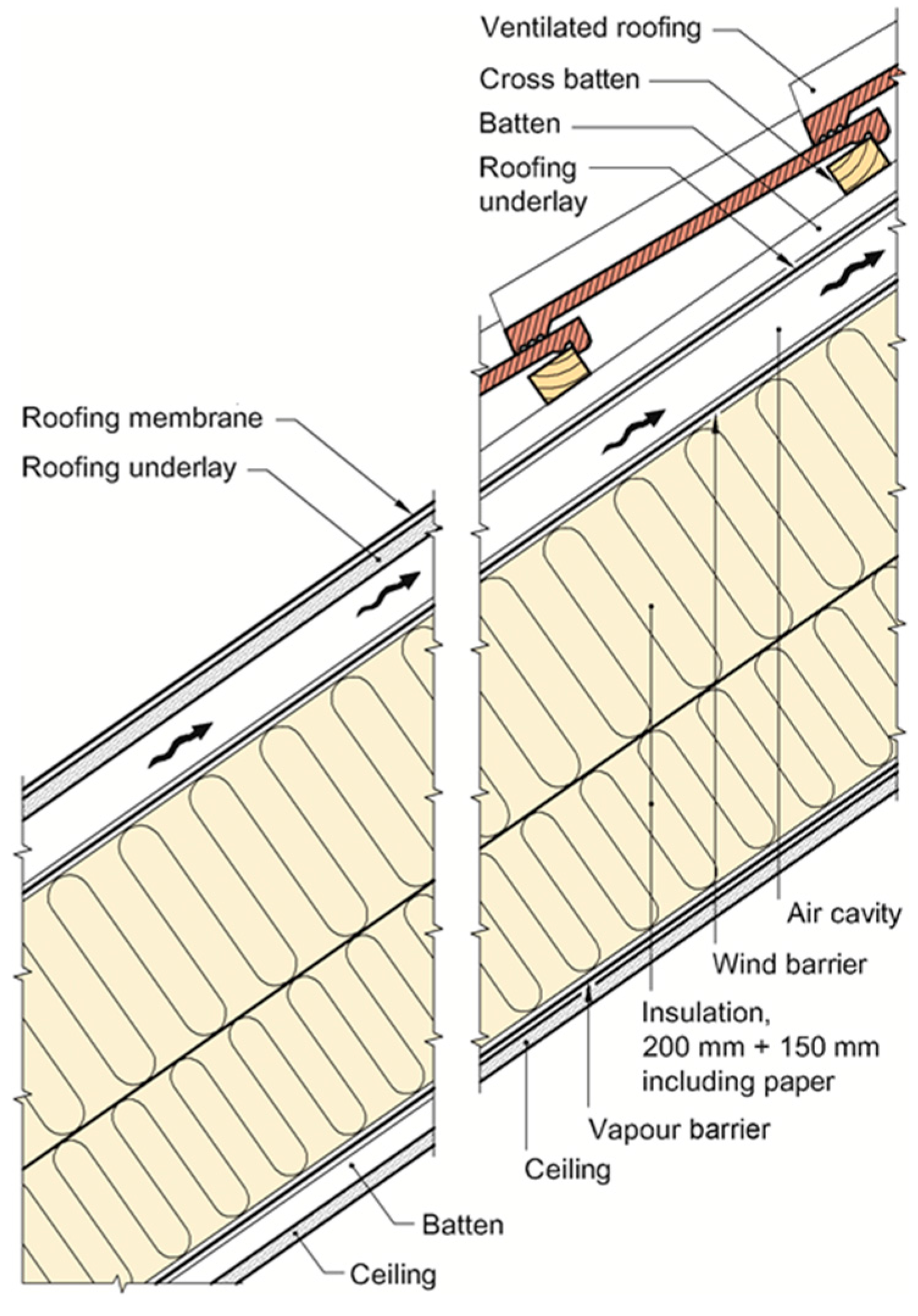
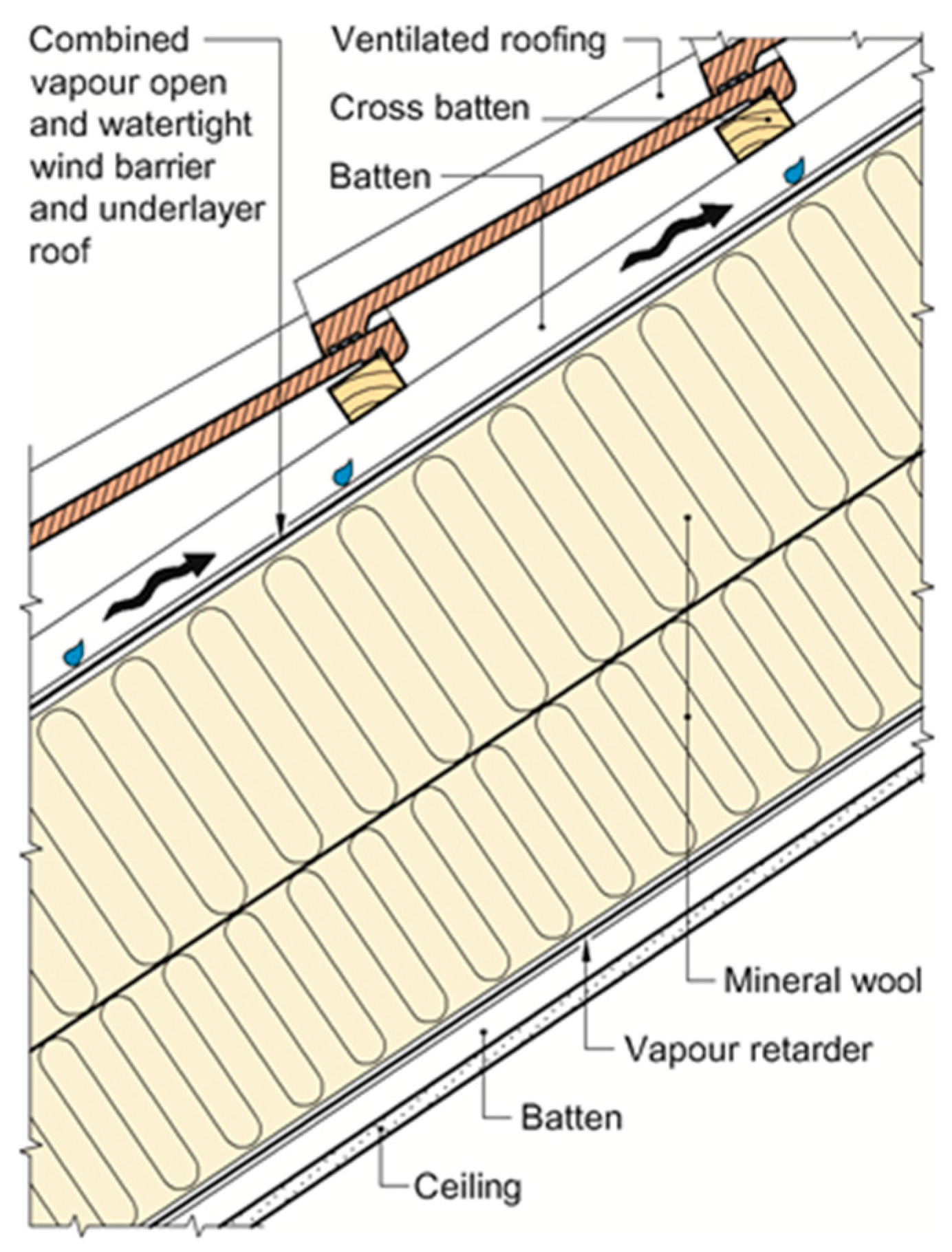



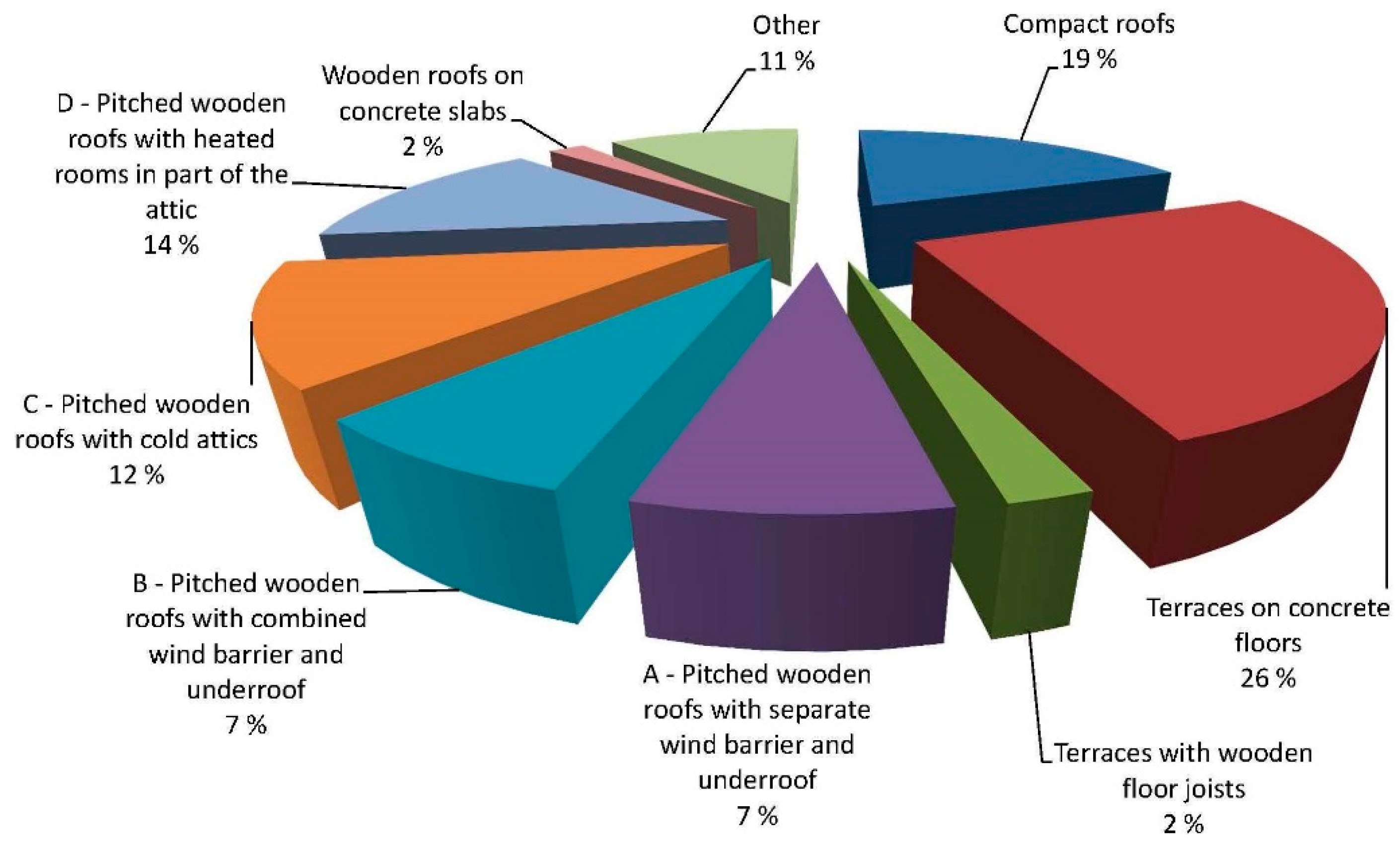
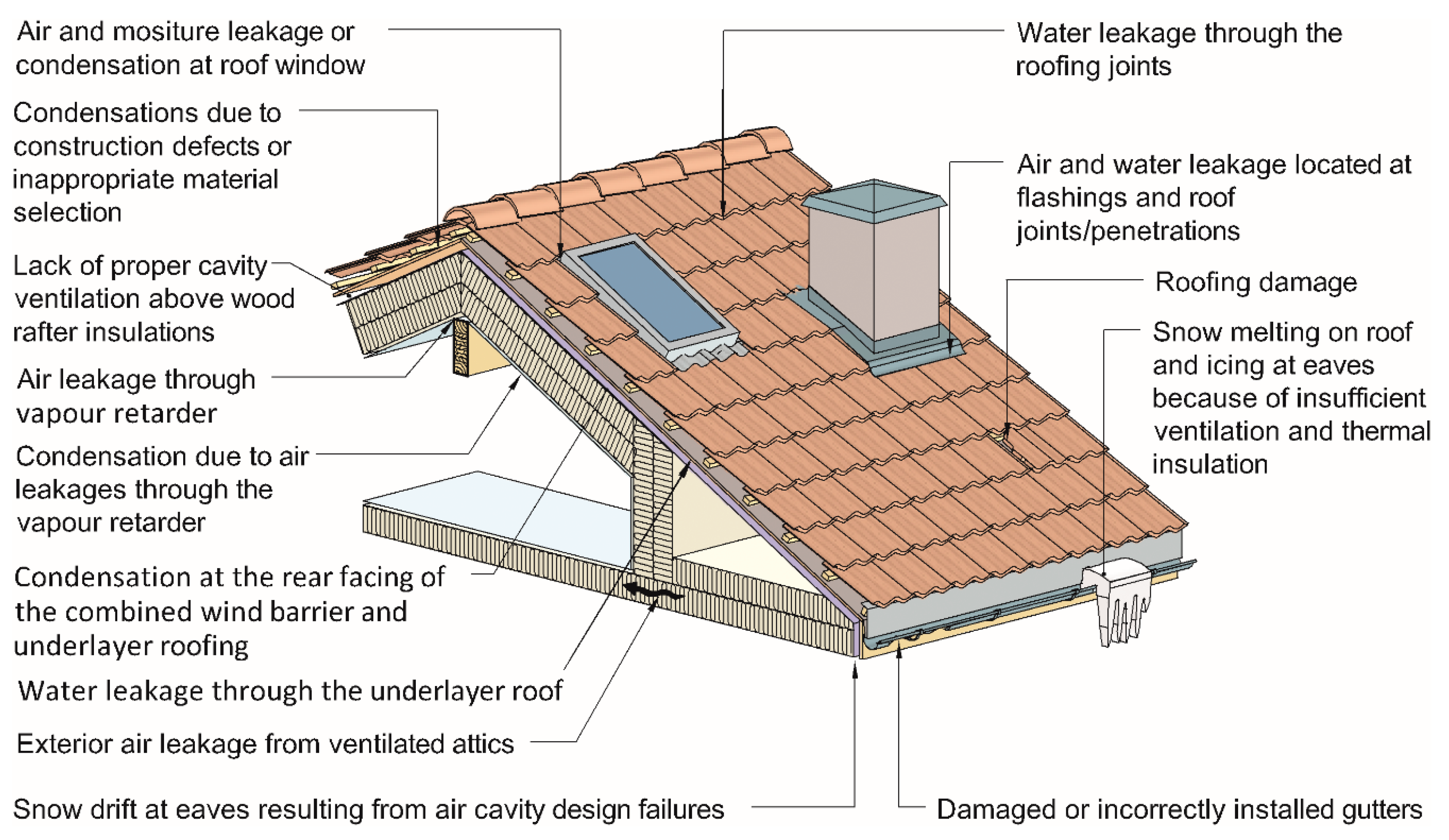
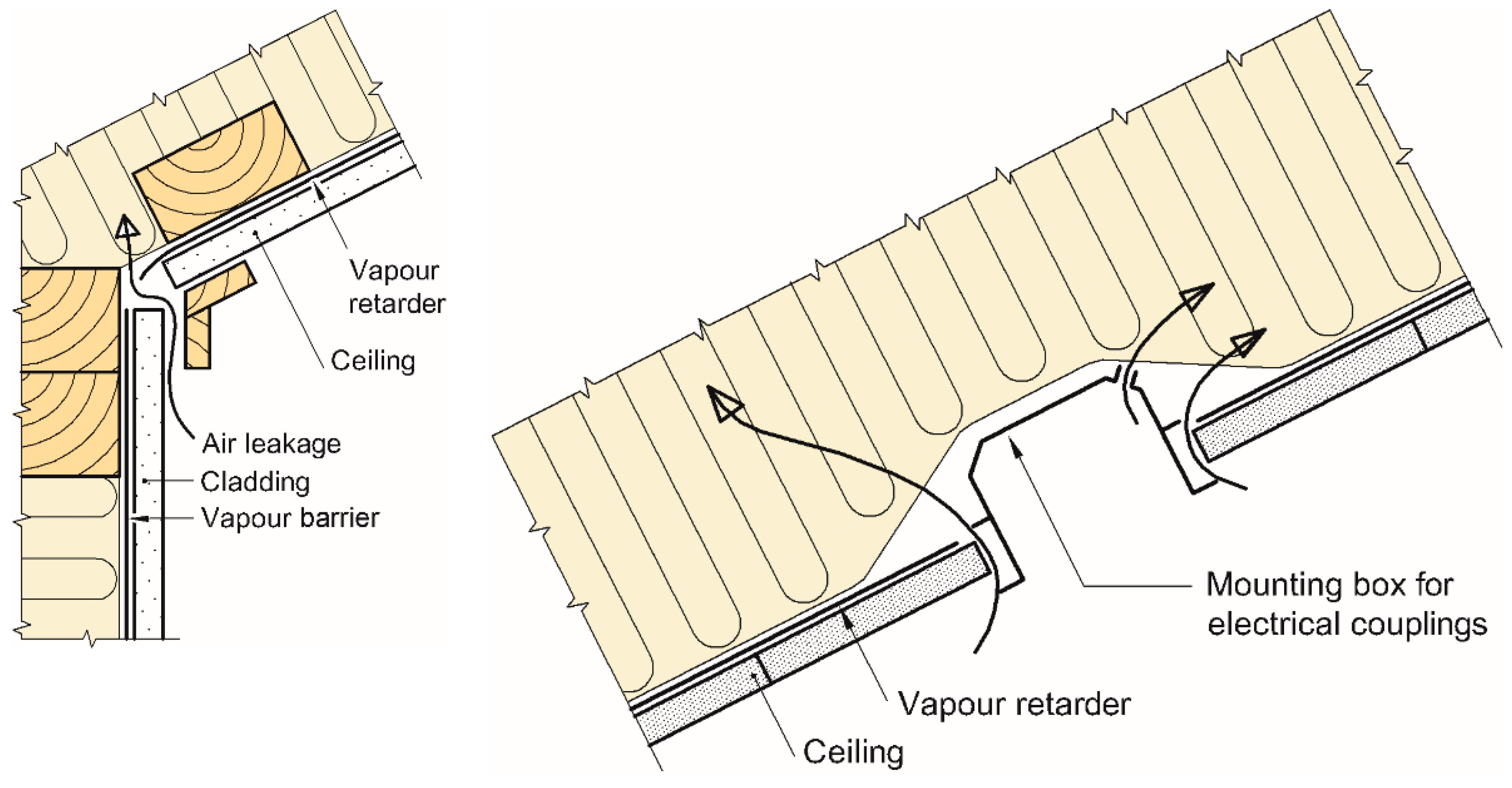
| Selection | Total Number of Defect Cases | Precipitation (%) | Indoor Moisture (%) | Built-in Moisture (%) | Water in Soil (%) | Leakage Water (from e.g., Sanitary Installations) (%) | Combinations of Moisture Sources (%) | Sources of Moisture in Combination with Other sources (%) | Other Sources (not Moisture Related) (%) (2) |
|---|---|---|---|---|---|---|---|---|---|
| Total amount of building defects | 2423 | 24 | 15 | 6 | 8 | 5 | 9 | 9 | 24 |
| Total amount of roof cases | 465 | 49 | 24 | 1 | 2 | 0 | 12 | 3 | 9 |
| 83 | 51 | 22 | 2 | 0 | 1 | 13 | 2 | 8 |
| 121 | 78 | 8 | 1 | 5 | 0 | 4 | 2 | 2 |
| 186 | 33 | 34 | 1 | 1 | 0 | 16 | 3 | 12 |
| 33 | 33 | 42 | 0 | 0 | 0 | 12 | 3 | 9 |
| 32 | 50 | 28 | 0 | 0 | 0 | 19 | 0 | 3 |
| 58 | 34 | 24 | 0 | 1 | 0 | 16 | 5 | 19 |
| 63 | 24 | 41 | 2 | 1 | 0 | 16 | 3 | 13 |
© 2016 by the authors; licensee MDPI, Basel, Switzerland. This article is an open access article distributed under the terms and conditions of the Creative Commons Attribution (CC-BY) license (http://creativecommons.org/licenses/by/4.0/).
Share and Cite
Gullbrekken, L.; Kvande, T.; Jelle, B.P.; Time, B. Norwegian Pitched Roof Defects. Buildings 2016, 6, 24. https://doi.org/10.3390/buildings6020024
Gullbrekken L, Kvande T, Jelle BP, Time B. Norwegian Pitched Roof Defects. Buildings. 2016; 6(2):24. https://doi.org/10.3390/buildings6020024
Chicago/Turabian StyleGullbrekken, Lars, Tore Kvande, Bjørn Petter Jelle, and Berit Time. 2016. "Norwegian Pitched Roof Defects" Buildings 6, no. 2: 24. https://doi.org/10.3390/buildings6020024
APA StyleGullbrekken, L., Kvande, T., Jelle, B. P., & Time, B. (2016). Norwegian Pitched Roof Defects. Buildings, 6(2), 24. https://doi.org/10.3390/buildings6020024






